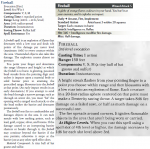JiffyPopTart
Bree-Yark
Powers don't use vague flowery language to describe what they do. They have CLEAR and precise language that tells you exactly what they do and they use the same language from one to the other so as long as you understand how powers are structured, they can throw as many of them at you as they want and you can always understand what they're supposed to do at a glance. Maybe they add a new keyword from time to time (Invigorating for exemple) but that's it.
100% how I would describe it. Any "flavor" to a power in 4e was distinctly moved to a different section of the layout than the rules portion and italicized to indicate it wasn't a rule...exactly like a MtG card. Throughout the different editions a player might ask how spells/powers interacted with the environment in cornercutting ways and usually referring to the entire text was how a GM would give a fair answer. In 4e there wasn't anything to "interpret". Just look at the differences in Fireball through the versions and how much (or little) there is about effects of the Fireball other than HP damage to players and objects.




